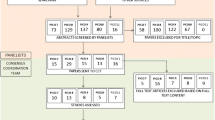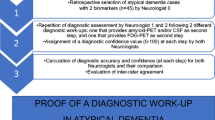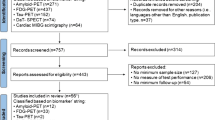Abstract
Purpose
We aim to present and critically evaluate the use of FDG-PET in the differential diagnosis between dementing conditions including Alzheimer disease (AD), frontotemporal dementia (FTD) and its variants, vascular dementia (VaD) and pseudodepressive dementia.
Methods
This review is based on the available consensus recommendations for the use of FDG-PET and current clinical diagnostic criteria. In addition, we updated these reviews with relevant publications in the field after conducting a literature search during the last 5 years through predefined keyword strings relating to the specific terms related to the diseases covered in this review and a common part (‘FDG-PET’).
Results
Neurodegenerative disease are complex groups of several forms of dementia and their clinical diagnostic criteria are progressively incorporating imaging biomarkers as a supporting tool. The role of FDG-PET is currently increasing as part of the clinical practice supporting the clinical diagnosis of AD (at both mild cognitive impairment—MCI—and early dementia stages), FTD and its variants, as well as VaD and pseudodepressive dementia. The pattern of AD is well defined and its negative predicted value may help the differential diagnosis when comorbidities like vascular disease or depression are present. However, the formal evidence supporting the use of FDG-PET is reasonable for MCI due to AD, and the differential diagnosis between FTD and AD, but lacking for the remaining clinical uses. Interestingly, the evidence provided during the last years reinforces these recommendations and gives additional clues about the usefulness of semiquantitative methods in addition to visual reading.
Conclusion
The large experience accumulated using FDG-PET for the differential diagnosis of the main conditions with dementia has been translated into more formal evidence to support its clinical use. Although FDG-PET form currently part of the clinical practice in many countries, there is still a lack of studies using standardized analysis that confirm specific patterns at individual level.






Similar content being viewed by others
References
Jack CR, Knopman DS, Jagust WJ et al (2013) Tracking pathophysiological processes in Alzheimer’s disease: an updated hypothetical model of dynamic biomarkers. Lancet Neurol 12:207–216. https://doi.org/10.1016/S1474-4422(12)70291-0
Lundgaard I, Li B, Xie L et al (2015) Direct neuronal glucose uptake heralds activity-dependent increases in cerebral metabolism. Nat Commun 6:6807. https://doi.org/10.1038/ncomms7807
Frisoni GB, Boccardi M, Barkhof F et al (2017) Strategic roadmap for an early diagnosis of Alzheimer’s disease based on biomarkers. Lancet Neurol 16:661–676. https://doi.org/10.1016/S1474-4422(17)30159-X
Nobili F, Arbizu J, Bouwman F et al (2018) European association of nuclear medicine and European academy of neurology recommendations for the use of brain 18 F-fluorodeoxyglucose positron emission tomography in neurodegenerative cognitive impairment and dementia: Delphi consensus. Eur J Neurol 25:1201–1217. https://doi.org/10.1111/ene.13728
McKhann GM, Knopman DS, Chertkow H et al (2011) The diagnosis of dementia due to Alzheimer’s disease: recommendations from the national institute on aging-alzheimer’s association workgroups on diagnostic guidelines for Alzheimer’s disease. Alzheimer’s Dement 7:263–269. https://doi.org/10.1016/j.jalz.2011.03.005
Dubois B, Feldman HH, Jacova C et al (2014) Advancing research diagnostic criteria for Alzheimer’s disease: the IWG-2 criteria. Lancet Neurol 13:614–629. https://doi.org/10.1016/S1474-4422(14)70090-0
Albert MS, DeKosky ST, Dickson D et al (2011) The diagnosis of mild cognitive impairment due to Alzheimer’s disease: recommendations from the national Institute on aging-Alzheimer’s association workgroups on diagnostic guidelines for Alzheimer’s disease. Alzheimer’s Dement 7:270–279. https://doi.org/10.1016/j.jalz.2011.03.008
Gorno-Tempini ML, Hillis AE, Weintraub S et al (2011) Classification of primary progressive aphasia and its variants. Neurology 76:1006–1014. https://doi.org/10.1212/WNL.0b013e31821103e6
Borroni B, Cosseddu M, Pilotto A et al (2015) Early stage of behavioral variant frontotemporal dementia: clinical and neuroimaging correlates. Neurobiol Aging 36:3108–3115. https://doi.org/10.1016/j.neurobiolaging.2015.07.019
Yuan Y, Gu ZX, Wei WS (2009) Fluorodeoxyglucose-positron-emission tomography, single-photon emission tomography, and structural MR imaging for prediction of rapid conversion to alzheimer disease in patients with mild cognitive impairment: a meta-analysis. Am J Neuroradiol 30:404–410. https://doi.org/10.3174/ajnr.A1357
Frisoni GB, Bocchetta M, Chételat G et al (2013) Imaging markers for Alzheimer disease: Which vs how. Neurology 81:487–500
Arbizu J, Festari C, Altomare D et al (2018) Clinical utility of FDG-PET for the clinical diagnosis in MCI. Eur J Nucl Med Mol Imaging 45:1497–1508. https://doi.org/10.1007/s00259-018-4039-7
Winblad B, Palmer K, Kivipelto M, et al (2004) Mild cognitive impairment—beyond controversies, towards a consensus: report of the international working group on mild cognitive impairment. En: Journal of Internal Medicine. Wiley, pp 240–246
Herholz K, Westwood S, Haense C, Dunn G (2011) Evaluation of a calibrated (18)F-FDG PET score as a biomarker for progression in Alzheimer disease and mild cognitive impairment. J Nucl Med 52:1218–1226. https://doi.org/10.2967/jnumed.111.090902
Chételat G, Desgranges B, de la Sayette V et al (2003) Mild cognitive impairment: Can FDG-PET predict who is to rapidly convert to Alzheimer’s disease? Neurology 60:1374–1377. https://doi.org/10.1212/01.wnl.0000055847.17752.e6
Drzezga A, Grimmer T, Riemenschneider M et al (2005) Prediction of individual clinical outcome in MCI by means of genetic assessment and 18F-FDG PET. J Nucl Med 46:1625–1632
Arbizu J, Prieto E, Martínez-Lage P et al (2013) Automated analysis of FDG PET as a tool for single-subject probabilistic prediction and detection of Alzheimer’s disease dementia. Eur J Nucl Med Mol Imaging 40:1394–1405. https://doi.org/10.1007/s00259-013-2458-z
Young J, Modat M, Cardoso MJ et al (2013) Accurate multimodal probabilistic prediction of conversion to Alzheimer’s disease in patients with mild cognitive impairment. NeuroImage Clin 2:735–745. https://doi.org/10.1016/j.nicl.2013.05.004
Ito K, Fukuyama H, Senda M et al (2015) Prediction of outcomes in mild cognitive impairment by Using 18F-FDG-PET: a multicenter study. J Alzheimer’s Dis 45:543–552. https://doi.org/10.3233/JAD-141338
Dubois B, Feldman HH, Jacova C et al (2010) Revising the definition of Alzheimer’s disease: a new lexicon. Lancet Neurol 9:1118–1127. https://doi.org/10.1016/S1474-4422(10)70223-4
Garibotto V, Borroni B, Kalbe E et al (2008) Education and occupation as proxies for reserve in aMCI converters and AD: FDG-PET evidence. Neurology 71:1342–1349. https://doi.org/10.1212/01.wnl.0000327670.62378.c0
Pagani M, Dessi B, Morbelli S et al (2010) MCI Patients declining and not-declining at mid-term follow-up: FDG-PET findings. Curr Alzheimer Res 7:287–294. https://doi.org/10.2174/156720510791162368
Grimmer T, Wutz C, Alexopoulos P et al (2016) Visual versus fully automated analyses of 18F-FDG and amyloid PET for prediction of dementia due to Alzheimer disease in mild cognitive impairment. J Nucl Med 57:204–207. https://doi.org/10.2967/jnumed.115.163717
Kim J, Cho S-G, Song M et al (2016) Usefulness of 3-dimensional stereotactic surface projection FDG PET images for the diagnosis of dementia. Medicine (Baltimore) 95:e5622. https://doi.org/10.1097/MD.0000000000005622
Kang JM, Lee JY, Kim YK et al (2018) Visual rating and computer-assisted analysis of FDG PET in the prediction of conversion to alzheimer’s disease in mild cognitive impairment. Mol Diagnosis Ther 22:475–483. https://doi.org/10.1007/s40291-018-0334-z
Kuang L, Zhao D, Xing J et al (2019) Metabolic Brain network analysis of FDG-PET in alzheimer’s disease using kernel-based persistent features. Molecules 24:2301. https://doi.org/10.3390/molecules24122301
Popuri K, Balachandar R, Alpert K et al (2018) Development and validation of a novel dementia of Alzheimer’s type (DAT) score based on metabolism FDG-PET imaging. NeuroImage Clin 18:802–813. https://doi.org/10.1016/j.nicl.2018.03.007
Yao Z, Hu B, Chen X et al (2018) Learning metabolic brain networks in MCI and AD by robustness and leave-one-out analysis: an FDG-PET study. Am J Alzheimers Dis Other Demen 33:42–54. https://doi.org/10.1177/1533317517731535
Pagani M, Giuliani A, Öberg J et al (2017) Progressive disintegration of brain networking from normal aging to alzheimer disease: analysis of independent components of 18 F-FDG PET data. J Nucl Med 58:1132–1139. https://doi.org/10.2967/jnumed.116.184309
Didic M, Felician O, Gour N et al (2015) Rhinal hypometabolism on FDG PET in healthy APO-E4 carriers: impact on memory function and metabolic networks. Eur J Nucl Med Mol Imaging 42:1512–1521. https://doi.org/10.1007/s00259-015-3057-y
Ottoy J, Niemantsverdriet E, Verhaeghe J et al (2019) Association of short-term cognitive decline and MCI-to-AD dementia conversion with CSF, MRI, amyloid- and 18F-FDG-PET imaging. NeuroImage Clin 22:101771. https://doi.org/10.1016/j.nicl.2019.101771
Riederer I, Bohn KP, Preibisch C et al (2018) Alzheimer disease and mild cognitive impairment: integrated pulsed arterial spin-labeling MRI and 18F-FDG PET. Radiology 288:198–206. https://doi.org/10.1148/radiol.2018170575
Stonnington CM, Chen Y, Savage CR et al (2018) Predicting imminent progression to clinically significant memory decline using volumetric MRI and FDG PET. J Alzheimers Dis 63:603–615. https://doi.org/10.3233/JAD-170852
Lange C, Suppa P, Frings L et al (2016) Optimization of statistical single subject analysis of brain FDG PET for the prognosis of mild cognitive impairment-to-alzheimer’s disease conversion. J Alzheimers Dis 49:945–959. https://doi.org/10.3233/JAD-150814
Caminiti SP, Ballarini T, Sala A et al (2018) FDG-PET and CSF biomarker accuracy in prediction of conversion to different dementias in a large multicentre MCI cohort. NeuroImage Clin 18:167–177. https://doi.org/10.1016/j.nicl.2018.01.019
Crutch SJ, Lehmann M, Schott JM et al (2012) Posterior cortical atrophy. Lancet Neurol 11:170–178
Laforce R, Buteau JP, Paquet N et al (2010) The value of PET in mild cognitive impairment, typical and atypical/unclear dementias: a retrospective memory clinic study. Am J Alzheimers Dis Other Demen 25:324–332. https://doi.org/10.1177/1533317510363468
Spehl TS, Hellwig S, Amtage F et al (2015) Syndrome-specific patterns of regional cerebral glucose metabolism in posterior cortical atrophy in comparison to dementia with Lewy bodies and Alzheimer’s disease–a [F-18]-FDG pet study. J Neuroimaging 25:281–288. https://doi.org/10.1111/jon.12104
Nestor PJ, Caine D, Fryer TD et al (2003) The topography of metabolic deficits in posterior cortical atrophy (the visual variant of Alzheimer’s disease) with FDG-PET. J Neurol Neurosurg Psychiatry 74:1521–1529. https://doi.org/10.1136/jnnp.74.11.1521
Whitwell JL, Duffy JR, Strand EA et al (2015) Clinical and neuroimaging biomarkers of amyloid-negative logopenic primary progressive aphasia. Brain Lang 142:45–53. https://doi.org/10.1016/j.bandl.2015.01.009
Nestor PJ, Altomare D, Festari C et al (2018) Clinical utility of FDG-PET for the differential diagnosis among the main forms of dementia. Eur J Nucl Med Mol Imaging 45:1509–1525. https://doi.org/10.1007/s00259-018-4035-y
Laforce R, Tosun D, Ghosh P et al (2014) Parallel ICA of FDG-PET and PiB-PET in three conditions with underlying Alzheimer’s pathology. NeuroImage Clin 4:508–516. https://doi.org/10.1016/j.nicl.2014.03.005
Sintini I, Schwarz CG, Martin PR et al (2019) Regional multimodal relationships between tau, hypometabolism, atrophy, and fractional anisotropy in atypical Alzheimer’s disease. Hum Brain Mapp 40:1618–1631. https://doi.org/10.1002/hbm.24473
Ossenkoppele R, Prins ND, Pijnenburg YAL et al (2013) Impact of molecular imaging on the diagnostic process in a memory clinic. Alzheimer’s Dement 9:414–421. https://doi.org/10.1016/j.jalz.2012.07.003
Woodward MC, Rowe CC, Jones G et al (2015) Differentiating the frontal presentation of Alzheimer’s disease with FDG-PET. J Alzheimer’s Dis 44:233–242. https://doi.org/10.3233/JAD-141110
Sorbi S, Hort J, Erkinjuntti T et al (2012) EFNS-ENS Guidelines on the diagnosis and management of disorders associated with dementia. Eur J Neurol 19:1159–1179. https://doi.org/10.1111/j.1468-1331.2012.03784.x
Rogalski E, Mesulam M (2009) Clinical trajectories and biological features of primary progressive aphasia (PPA). Curr Alzheimer Res 6:331–336. https://doi.org/10.2174/156720509788929264
Rascovsky K, Hodges JR, Knopman D et al (2011) Sensitivity of revised diagnostic criteria for the behavioural variant of frontotemporal dementia. Brain 134:2456–2477. https://doi.org/10.1093/brain/awr179
Kipps CM, Hodges JR, Fryer TD, Nestor PJ (2009) Combined magnetic resonance imaging and positron emission tomography brain imaging in behavioural variant frontotemporal degeneration: Refining the clinical phenotype. Brain 132:2566–2578. https://doi.org/10.1093/brain/awp077
Devenney E, Bartley L, Hoon C et al (2015) Progression in behavioral variant frontotemporal dementia: A longitudinal study. JAMA Neurol 72:1501–1509. https://doi.org/10.1001/jamaneurol.2015.2061
Ranasinghe KG, Rankin KP, Pressman PS et al (2016) Distinct subtypes of Bvftd based on patterns of network degeneration. JAMA Neurology 73:1078–1088. https://doi.org/10.1001/jamaneurol.2016.2016.Distinct
Cerami C, Dodich A, Lettieri G et al (2016) Different FDG-PET metabolic patterns at single-subject level in the behavioral variant of fronto-temporal dementia. Cortex 83:101–112. https://doi.org/10.1016/j.cortex.2016.07.008
Fernández-Matarrubia M, Matías-Guiu JA, Cabrera-Martín MN et al (2017) Episodic memory dysfunction in behavioral variant frontotemporal dementia: a clinical and FDG-PET study. J Alzheimer’s Dis 57:1251–1264. https://doi.org/10.3233/JAD-160874
Devenney E, Swinn T, Mioshi E et al (2018) The behavioural variant frontotemporal dementia phenocopy syndrome is a distinct entity—evidence from a longitudinal study. BMC Neurol 18:1–6. https://doi.org/10.1186/s12883-018-1060-1
Mandelli ML, Vitali P, Santos M, Henry M, Gola K, Rosenberg L, Dronkers N, Miller B, Seeley WW, Gorno-Tempini ML (2016) Two insular regions are differentially involved in behavioral variant FTD and nonfluent/agrammatic variant PPA. Cortex 74:149–157. https://doi.org/10.1016/j.cortex.2015.10.012
Vijverberg EGB, Wattjes MP, Dols A et al (2016) Diagnostic accuracy of MRI and additional [18F]FDG-PET for behavioral variant frontotemporal dementia in patients with late onset behavioral changes. J Alzheimer’s Dis 53:1287–1297. https://doi.org/10.3233/JAD-160285
Mosconi L, Tsui WH, Herholz K et al (2008) Multicenter standardized 18F-FDG PET diagnosis of mild cognitive impairment, Alzheimer’s disease, and other dementias. J Nucl Med 49:390–398. https://doi.org/10.2967/jnumed.107.045385
Foster NL, Heidebrink JL, Clark CM et al (2007) FDG-PET improves accuracy in distinguishing frontotemporal dementia and Alzheimer’s disease. Brain 130:2616–2635. https://doi.org/10.1093/brain/awm177
Rabinovici GD, Rosen HJ, Alkalay A et al (2011) Amyloid vs FDG-PET in the differential diagnosis of AD and FTLD. Neurology 77:2034–2042. https://doi.org/10.1212/WNL.0b013e31823b9c5e
Matias-Guiu JA, Cabrera-Martín MN, García-Ramos R et al (2014) Evaluation of the new consensus criteria for the diagnosis of primary progressive aphasia using fluorodeoxyglucose positron emission tomography. Dement Geriatr Cogn Disord 38:147–152. https://doi.org/10.1159/000358233
Taswell C, Villemagne VL, Yates P et al (2015) 18F-FDG PET improves diagnosis in patients with focal-onset dementias. J Nucl Med 56:1547–1553. https://doi.org/10.2967/jnumed.115.161067
Santos-Santos MA, Rabinovici GD, Iaccarino L et al (2018) Rates of amyloid imaging positivity in patients with primary progressive aphasia. JAMA Neurol 75:342–352. https://doi.org/10.1001/jamaneurol.2017.4309
Montembeault M, Brambati SM, Gorno-Tempini ML, Migliaccio R (2018) Clinical, anatomical, and pathological features in the three variants of primary progressive aphasia: a review. Front Neurol 9:692. https://doi.org/10.3389/fneur.2018.00692
Harris JM, Jones M (2014) Pathology in primary progressive aphasia syndromes. Curr Neurol Neurosci Rep 14:466. https://doi.org/10.1007/s11910-014-0466-4
Bergeron D, Gorno-Tempini ML, Rabinovici GD et al (2018) Prevalence of amyloid-β pathology in distinct variants of primary progressive aphasia. Ann Neurol 84:729–740. https://doi.org/10.1002/ana.25333
Matías-Guiu JA, Cabrera-Martín MN, Moreno-Ramos T et al (2015) Amyloid and FDG-PET study of logopenic primary progressive aphasia: evidence for the existence of two subtypes. J Neurol 262:1463–1472. https://doi.org/10.1007/s00415-015-7738-z
Matias-Guiu JA, Díaz-Álvarez J, Cuetos F et al (2019) Machine learning in the clinical and language characterisation of primary progressive aphasia variants. Cortex 119:312–323. https://doi.org/10.1016/j.cortex.2019.05.007
Matias-Guiu JA, Díaz-Álvarez J, Ayala JL et al (2018) Clustering analysis of FDG-PET imaging in primary progressive aphasia. Front Aging Neurosci 10:1–12. https://doi.org/10.3389/fnagi.2018.00230
Bouwman F, Orini S, Gandolfo F et al (2018) Diagnostic utility of FDG-PET in the differential diagnosis between different forms of primary progressive aphasia. Eur J Nucl Med Mol Imaging 45:1526–1533. https://doi.org/10.1007/s00259-018-4034-z
Jorm AF, Jolley D (1998) The incidence of dementia: a meta-analysis. Neurology 51:728–733. https://doi.org/10.1212/WNL.51.3.728
Gorelick PB (2004) Risk factors for vascular dementia and Alzheimer disease. Stroke 35:2620–2622. https://doi.org/10.1161/01.STR.0000143318.70292.47
O’Brien JT, Thomas A (2015) Vascular dementia. Lancet 386:1698–1706. https://doi.org/10.1016/S0140-6736(15)00463-8
Toledo JB, Arnold SE, Raible K et al (2013) Contribution of cerebrovascular disease in autopsy confirmed neurodegenerative disease cases in the national alzheimer’s coordinating centre. Brain 136:2697–2706. https://doi.org/10.1093/brain/awt188
MacLin JMA, Wang T, Xiao S (2019) Biomarkers for the diagnosis of Alzheimer’s disease, dementia Lewy body, frontotemporal dementia and vascular dementia. Gen Psychiatry 32:5–13. https://doi.org/10.1136/gpsych-2019-100054
Seo SW, Cho SS, Park A et al (2009) Subcortical vascular versus amnestic mild cognitive impairment: comparison of cerebral glucose metabolism. J Neuroimaging 19:213–219. https://doi.org/10.1111/j.1552-6569.2008.00292.x
Pascual B, Prieto E, Arbizu J et al (2010) Brain glucose metabolism in vascular white matter disease with dementia: differentiation from Alzheimer disease. Stroke 41:2889–2893. https://doi.org/10.1161/STROKEAHA.110.591552
Kerrouche N, Herholz K, Mielke R et al (2006) 18FDG PET in vascular dementia: differentiation from Alzheimer’s disease using voxel-based multivariate analysis. J Cereb Blood Flow Metab 26:1213–1221. https://doi.org/10.1038/sj.jcbfm.9600296
Vishnu VY, Modi M, Garg VK et al (2017) Role of inflammatory and hemostatic biomarkers in Alzheimer’s and vascular dementia—a pilot study from a tertiary center in Northern India. Asian J Psychiatr 29:59–62. https://doi.org/10.1016/j.ajp.2017.04.015
Djukic M, Wedekind D, Franz A et al (2015) Frequency of dementia syndromes with a potentially treatable cause in geriatric in-patients: analysis of a 1-year interval. Eur Arch Psychiatry Clin Neurosci 265:429–438. https://doi.org/10.1007/s00406-015-0583-3
Kang H, Zhao F, You L, Giorgetta C, Sarkhel SPR (2014) Pseudo-dementia: a neuropsychological review. Ann Indian Acad Neurol 17:147–154. https://doi.org/10.4103/0972-2327.132613
Fu C, Zhang H, Xuan A et al (2018) A combined study of 18F-FDG PET-CT and fMRI for assessing resting cerebral function in patients with major depressive disorder. Exp Ther Med 16:1873–1881. https://doi.org/10.3892/etm.2018.6434
Lee HS, Il CH, Lee DY et al (2010) Frontal dysfunction underlies depression in mild cognitive impairment: a FDG-PET study. Psychiatry Investig 7:208–214. https://doi.org/10.4306/pi.2010.7.3.208
Youn HC, Lee ES, Lee S et al (2018) Regional glucose metabolism due to the presence of cerebral amyloidopathy in older adults with depression and mild cognitive impairment. J Affect Disord 239:30–36. https://doi.org/10.1016/j.jad.2018.06.029
Funding
This study was not funded by grants.
Author information
Authors and Affiliations
Contributions
EFG, DL, JJR and JA: literature search and review. All authors: manuscript writing and editing.
Corresponding author
Ethics declarations
Ethical standards
This article does not contain any studies with human or animal subjects performed by the any of the authors.
Additional information
Publisher's Note
Springer Nature remains neutral with regard to jurisdictional claims in published maps and institutional affiliations.
Rights and permissions
About this article
Cite this article
Guillén, E.F., Rosales, J.J., Lisei, D. et al. Current role of 18F-FDG-PET in the differential diagnosis of the main forms of dementia. Clin Transl Imaging 8, 127–140 (2020). https://doi.org/10.1007/s40336-020-00366-0
Received:
Accepted:
Published:
Issue Date:
DOI: https://doi.org/10.1007/s40336-020-00366-0




